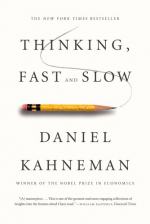
|
| Name: _________________________ | Period: ___________________ |
This test consists of 15 multiple choice questions and 5 short answer questions.
Multiple Choice Questions
1. What illusion is posed by the author in Chapter 6 when he asks about how many animals were brought upon the ark?
(a) The Biblical Illusion.
(b) The Noah Illusion.
(c) The Muller-Lyer illusion.The
(d) The Moses Illusion.
2. Extreme predictions and willingness to predict events from weak evidence are manifestations of what?
(a) System 1.
(b) Arrogance.
(c) Confidence.
(d) System 2.
3. What term refers to an approach to problem solving that employs a practical method not guaranteed to be perfect, but sufficient for the immediate goals?
(a) Illusion.
(b) Executive control.
(c) Heuristic.
(d) Causality.
4. What statistician illustrated the ease with which people see patterns where none exist?
(a) Larry Jacoby.
(b) William Feller.
(c) Christopher Chabris.
(d) Eckhard Hess.
5. What term is used to describe the adoption and termination of task sets by psychologists?
(a) Subconscious control.
(b) Executive control.
(c) Active control.
(d) Cognitive Pupillometry.
6. Who coined the term "mere exposure effect"?
(a) Daniel Gilbert.
(b) Shane Frederick.
(c) Danny Oppenheimer.
(d) Robert Zajonc.
7. In conducting their wheel of fortune study, Kahneman and Tversky set their wheel to only stop on what numbers?
(a) 4 or 89.
(b) 12 or 98.
(c) 13 or 16.
(d) 10 or 65.
8. In the example where the author presents two candidates for a college professorship, which choice is favored by intuition?
(a) Jane.
(b) Sarah.
(c) Kim.
(d) Anne.
9. What neighborhood within Niagara Falls, New York was the location of a 70-acre landfill that was the epicenter of a massive environmental disaster?
(a) Union City.
(b) Almeda.
(c) Patterson.
(d) Love Canal.
10. What do we lose touch with when we are uncomfortable or unhappy?
(a) Articulation.
(b) Recognition.
(c) Intuition.
(d) Admiration.
11. The author compares the conscious mind with what in Chapter 5?
(a) A cemetery.
(b) A ship's hull.
(c) A ship's mast.
(d) A cockpit.
12. Who discovered a named regression to the mean?
(a) John List.
(b) Sir Francis Galton.
(c) Gary Klein.
(d) Christopher Hsee.
13. What German psychologists offered the most compelling demonstrations of the role of associative coherence in anchoring, according to the author?
(a) Thomas Mussweiler and Fritz Strack.
(b) Larry Jacoby.
(c) William Feller.
(d) Christopher Chabris and Daniel Simons.
14. According to the author, the dynamics of what help explain the recurrent cycles of disaster, concern, and complacency that are familiar to students of large-scale emergencies?
(a) Memory.
(b) Causality.
(c) Prediction.
(d) Consciousness.
15. What occurs when people consider a particular value for an unknown quantity before estimating that quantity?
(a) An anchoring effect.
(b) Artifacts.
(c) Cognitive Pupillometry.
(d) Ego depletion.
Short Answer Questions
1. In the conclusion of the study of availability bias conducted by Paul Slovic, Sarah Lichtenstein, and Baruch Fischoff, they deduced that estimates of causes of death are warped by what?
2. What are statistical base rates?
3. Who introduced the labels System 1 and System 2 as systems of the mind?
4. What do causal base rates do?
5. What word is used to describe when people fail to apply a logical rule that is obviously relevant?
|
This section contains 510 words (approx. 2 pages at 300 words per page) |

|




